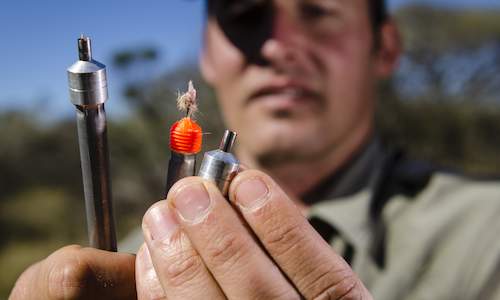Kruger Park News Archive

The regulations also seek to promote ethical hunting practises within the hunting fraternity and encourage black empowerment of the industry through the formation of a national association of hunting organisations that will have legal recognition with the department of Environmental Affairs and Tourism.Two sets of new regulations laying out these laws were published simultaneously on May 5, 2006, governing both the hunting industry and hunting and other activities involving species that are listed as threatened or protected in South Africa. The norms and standards provide for the first time a national framework for South Africa that standardises the permit system that regulates the industry.
In the past, different provinces had different hunting regulations and regarded species differently. They also varied widely in the enforcement of provincial legislation dealing with hunting and breeding permits. The new regulations outlaw the breeding of any large predator, such as lion, leopard, cheetah and wild dog for hunting purposes.Any predator that is captive bred has to have been rehabilitated and living freely for a minimum of two years before it can be hunted. Hunting on private land that has dropped fences with adjoining national and provincial parks is also limited by the regulations.
Hunting is only permitted on this land if the private landowner has a formal agreement with the neighbouring management authority, and this has been approved by either the MEC in the case of provincial parks, or by the minister of environmental affairs in the case of national parks.The hunting of damage-causing animals for profit is now forbidden, with the regulations stipulating that damage-causing animals must be "culled". If the animal has escaped from a protected area, then the management of the protected area must first try and retrieve the animal, and if this fails they can then cull the animal.
If the damage-causing animal naturally occurs in the area, then the affected parties can call in the nature conservation department, who have to try to translocate the animal to another suitable area. Previously nature conservation had to destroy damage-causing animals that had escaped from protected areas, and sometimes put this out to tender to professional hunters.So-called "green hunting" where a hunter darts an animal, has his photo taken with the trophy and then the animal is revived is also stopped by the new regulations. They state that only a vet can use darts, and only in the case of protected species that require treatment, translocation, disease control, or as part of a scientific experiment. Vets acting under these circumstances are also the only individuals allowed to use aircraft or motorised vehicles and spot lights to find their targets.Hunters may use motorised vehicles only to track animals over long distances, but cannot shoot an animal from a vehicle unless it is wounded. Bow hunting and baiting of animals is in general prohibited, but may be carried out if it is specifically allowed by provincial legislation, with baiting only being permissible for lions and leopards, and only with dead bait.
Also prohibited is the use of poison, traps, snares, any firearm other than a rifle or a hunting handgun, spears, and air guns. Dogs may only be used to track wounded animals and can point and retrieve in the case of listed bird species.In order to ensure that the whole game breeding and hunting industry is better regulated, especially in the case of rare and endangered species, all captive breeding and animals rehabilitation facilities will have to be registered at a national level, within three months of the laws being passed.
The department of environmental affairs will also be establishing a scientific authority. This will help determine national off-take levels for hunting protected species, and decide the provincial distribution of these permits. The body will consist of officials from the department of environmental affairs, provincial biodiversity officials, Sanparks, Sanbi (South African National Biodiversity Institute), the natural history museums and the National Zoological Gardens.More stringent reporting of hunting activities will also be required, with hunters being required to provide feedback to provincial authorities regarding hunts that they have been allocated. In turn, the provincial department will send these statistics to Sanbi, who will compile a national hunting register that details how, where, and why animals have been hunted in South Africa.Announcing the new legislation, environment minister Marthinus van Schalkwyk said, Issues of breeding, trade, and hunting of protected and endangered species remain amongst the most important and sensitive considerations in any national conservation and biodiversity strategy.
We believe that these two draft documents take South African conservation to new heights and that they establish a system to provide muchneeded clarity and direction..... No longer will there be any excuses for [the] abuse of our natural heritage."

 The hunter stalks his prey, a huge elephant bull. He stops, a shot is fired. The shot is a good one, but the elephant doesn't drop immediate...
The hunter stalks his prey, a huge elephant bull. He stops, a shot is fired. The shot is a good one, but the elephant doesn't drop immediate...